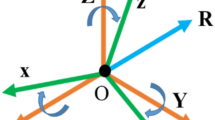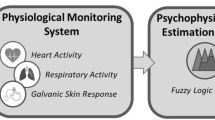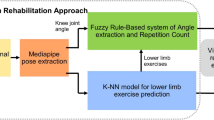Abstract
The progressive aging of the population in developed countries is becoming a problem for healthcare systems, which must invest ever higher sums in caring for their older citizens. One of the most important issues in this area involves the physical and cognitive problems associated with growing old. In order to reduce the effect of these problems, gerontechnology has emerged as one of the most promising alternatives, especially in the field of the telerehabilitation systems developed to date. However, most of these systems do not offer therapists the facilities to design therapies adapted to individual patients. This paper proposes a novel system that supplies this need and enables therapists to create bespoke motor therapies as state diagrams and manage them efficiently in a collaborative setting. The proposed system is equipped with a fuzzy-based decision-making component that therapists can use to control transitioning between states according to variables such as fatigue and performance. Therefore, the system makes it feasible to provide older patients with the treatment they need in their own homes while its effectiveness is controlled by a Fuzzy Inference System.














Similar content being viewed by others
Explore related subjects
Discover the latest articles, news and stories from top researchers in related subjects.References
Costa Â, Castillo JC, Novais P, Fernández-Caballero A, Simoes R. Sensor-driven agenda for intelligent home care of the elderly. Expert Syst Appl. 2012;39:12192–204.
European Commission Information Society and Media, editor. ICT for health and i2010: transforming the European healthcare landscape towards a strategy for ICT for Health. Luxembourg: European Commission Information Society and Media; 2006.
Fozard JL, Rietsema J, Bouma H, Graafmans JAM. Gerontechnology: creating enabling environments for the challenges and opportunities of aging. Educ Gerontol. 2000;26:331–44.
Van Bronswijk JEMH, Bouma H, Fozard JL. Technology for quality of life: an enriched taxonomy. Gerontechnology. 2002. doi:10.4017/gt.2002.02.02.001.00.
Boucenna S, Narzisi A, Tilmont E, Muratori F, Pioggia G, Cohen D, Chetouani M. Interactive technologies for autistic children: a review. Cognit Comput. 2014;6:722–40.
Brennan DM, Georgeadis AC, Baron CR, Barker LM. The effect of videoconference-based telerehabilitation on story retelling performance by brain-injured subjects and its implications for remote speech-language therapy. Telemed J E Health. 2004;10:147–54.
Vaughn GR. Tel-communicology: health-care delivery system for persons with communicative disorders. ASHA. 1976;18:13–7.
Parmanto B, Saptono A. Telerehabilitation: state-of-the-art from an informatics perspective. Int J Telerehabilitation. 2009;1:73–84.
Da Gama A, Chaves T, Figueiredo L, Teichrieb V. Improving motor rehabilitation process through a natural interaction based system using Kinect sensor. In: 2012 IEEE symposium 3D user interfaces. IEEE; 2012. p. 145–46.
Chang Y-J, Chen S-F, Huang J-D. A Kinect-based system for physical rehabilitation: a pilot study for young adults with motor disabilities. Res Dev Disabil. 2011;32:2566–70.
Oliver M, Molina JP, Montero F, González P, Fernández-Caballero A. Wireless multisensory interaction in an intelligent rehabilitation environment. In: Ramos C, Novais P, Nihan CE, Corchado Rodríguez JM, editors. 5th International symposium ambient intelligence. Cham: Springer International Publishing; 2014. p. 193–200.
Gascueña JM, Castillo JC, Navarro E, Fernández-Caballero A. Engineering the development of systems for multisensory monitoring and activity interpretation. Int J Syst Sci. 2014;45:728–40.
Chang C-Y, Lange B, Zhang M, Koenig S, Requejo P, Somboon N, Sawchuk AA, Rizzo AA. Towards pervasive physical rehabilitation using Microsoft Kinect. 2012. p. 159–62.
Ross TJ. Fuzzy logic with engineering applications. Hightstown: McGraw-Hill; 1995.
Gnjatović M. Therapist-centered design of a robot’s dialogue behavior. Cognit Comput. 2014;6:775–88.
Lange B, Chang C-Y, Suma E, Newman B, Rizzo AS, Bolas M. Development and evaluation of low cost game-based balance rehabilitation tool using the Microsoft Kinect sensor. In: IEEE engineering in medicine and biology society (EMBC 2011). IEEE; 2011. p. 1831–34.
Meldrum D, Glennon A, Herdman S, Murray D, McConn-Walsh R. Virtual reality rehabilitation of balance: assessment of the usability of the nintendo Wii® Fit Plus. Disabil Rehabil Assist Technol. 2012;7:205–10.
Montero F, López-Jaquero V, Navarro E, Sánchez E. Computer-aided relearning activity patterns for people with acquired brain injury. Comput Educ. 2011;57:1149–59.
Oliver M, Montero F, Fernández-Caballero A, González P, Molina JP. RGB-D assistive technologies for acquired brain injury: description and assessment of user experience. Expert Syst. 2014. doi:10.1111/exsy.12096.
Microsoft (2011) Welcome to Microsoft PixelSense. http://www.microsoft.com/en-us/pixelsense/default.aspx.
Fernández Valls JA, Penichet VMR, Lozano MD. Virtual 3D web environment for posture design in rehabilitation using Kinect. In: 8th International conference pervasive computing. Technologies for healthcare. 2014. p. 298–301.
Schonauer C, Pintaric T, Kaufmann H, Jansen-Kosterink S, Vollenbroek-Hutten M. Chronic pain rehabilitation with a serious game using multimodal input. In: International conference on virtual rehabilitation. IEEE; 2011. p. 1–8.
Tsekleves E, Warland A, Kilbride C, Paraskevopoulos I, Skordoulis D. The use of the Nintendo Wii in motor rehabilitation for virtual reality interventions: a literature review. In: Parsons TD, Trost Z (eds) Virtual, augmented reality and serious games for healthcare, vol. 1. Springer; 2014. p. 523–46.
Tsaur R-C, Kuo T-C. Tourism demand forecasting using a novel high-precision fuzzy time series model. Int J Innov Comput Inf Control. 2014;10:695–701.
Zhou M, Li S. Applications of bipolar fuzzy theory to hemirings. Int J Innov Comput Inf Control. 2014;10:767–81.
Li F, Shi P, Wu L, Zhang X. Fuzzy-model-based D-stability and Nonfragile control for discrete-time descriptor systems with multiple delays. IEEE Trans Fuzzy Syst. 2014;22:1019–25.
Tseng BY, Billinger SA, Gajewski BJ, Kluding PM. Exertion fatigue and chronic fatigue are two distinct constructs in people post-stroke. Stroke. 2010;41:2908–12.
Huq R, Wang R, Lu E, Hébert D, Lacheray H, Mihailidis A. (2013) Development of a fuzzy logic based intelligent system for autonomous guidance of post-stroke rehabilitation exercise. In: IEEE international conference on rehabilitation exercise. Seattle: IEEE; 2013. p. 1–8.
Yang C. Fatigue effect on task performance in haptic virtual environment for home-based rehabilitation. Saskatoon: University of Saskatchewan; 2011.
Barghout A, Alamri A, Eid M, Saddik AE. Haptic rehabilitation exercises performance evaluation using fuzzy inference systems. In: IEEE international workshop on medical measurements and applications. 2008. p. 13–18.
Barghout A, Alamri A, Eid M, Saddik AE. Haptic rehabilitation exercises performance evaluation using automated inference systems. Int J Adv Media Commun. 2009;3:197.
Zhang Z, Fang Q, Gu X. Fuzzy inference system based automatic Brunnstrom stage classification for upper-extremity rehabilitation. Expert Syst App. 2014;41:1973–80.
Pirovano M, Mainetti R, Baud-Bovy G, Lanzi PL, Borghese NA. Self-adaptive games for rehabilitation at home. In: IEEE conference on computational intelligence and games (CIG 2012). IEEE; 2012. p. 179–86.
Gopalai AA, Senanayake SMNA. A wearable real-time intelligent posture corrective system using vibrotactile feedback. IEEE/ASME Trans Mechatron. 2011;16:827–34.
Martin P, Emami MR (2010) Neuro-fuzzy compliance control for rehabilitation robotics. In: 3rd IEEE RAS EMBS international conference biomedical robotics and biomechatronics. Tokyo: IEEE; 2010. p. 560–65.
Segundo U, López-Cuadrado J, Aldamiz-Echevarria L, Pérez TA, Buenestado D, Iruetaguena A, Barrena R, Pikatza JM. Automatic construction of fuzzy inference systems for computerized clinical guidelines and protocols. Appl Soft Comput. 2015;26:257–69.
Best-Martini E, Jones-DiGenova KA. Exercise for frail elders, 2nd ed. Human kinetics. 2014.
Rodríguez AC, Roda C, Montero F, González P, Navarro E. A collaborative system for designing tele-therapies. In: Workshop on user and ambient adaptive gerontechnologies. Belfast: Springer International Publishing; 2014. p. 377–385.
Olsen D. Evaluating user interface systems research. In: Proceedings of the 20th annual ACM symposium user interface software technology. 2007. p. 251–58.
Greenberg S, Buxton B. Usability evaluation considered harmful (some of the time). In: 26th annual CHI Conference on human factors in computer systems (CHI 08). 2008. 111 pp.
Gascueña JM, Navarro E, Fernández-Sotos P, Fernández-Caballero A, Pavón J. IDK and ICARO to develop multi-agent systems in support of ambient intelligence. J Intell Fuzzy Syst. 2015;28:3–15.
Roda C, Rodríguez A, López-jaquero V, González P, Navarro E. A multi-agent system in ambient intelligence for the physical rehabilitation of older people. In: 13th Conference on practical applications of agents and multi-agent systems. 2015. p. 113–123
Acknowledgments
This work was partially supported by Spanish Ministerio de Economía y Competitividad/FEDER under TIN2012-34003 grant and through an FPU scholarship (FPU12/04962) from the Spanish Government. We are also indebted to the specialists of the ADACE association for their invaluable cooperation.
Author information
Authors and Affiliations
Corresponding author
Rights and permissions
About this article
Cite this article
Rodríguez, A.C., Roda, C., Montero, F. et al. An Interactive Fuzzy Inference System for Teletherapy of Older People. Cogn Comput 8, 318–335 (2016). https://doi.org/10.1007/s12559-015-9356-6
Received:
Accepted:
Published:
Issue Date:
DOI: https://doi.org/10.1007/s12559-015-9356-6




